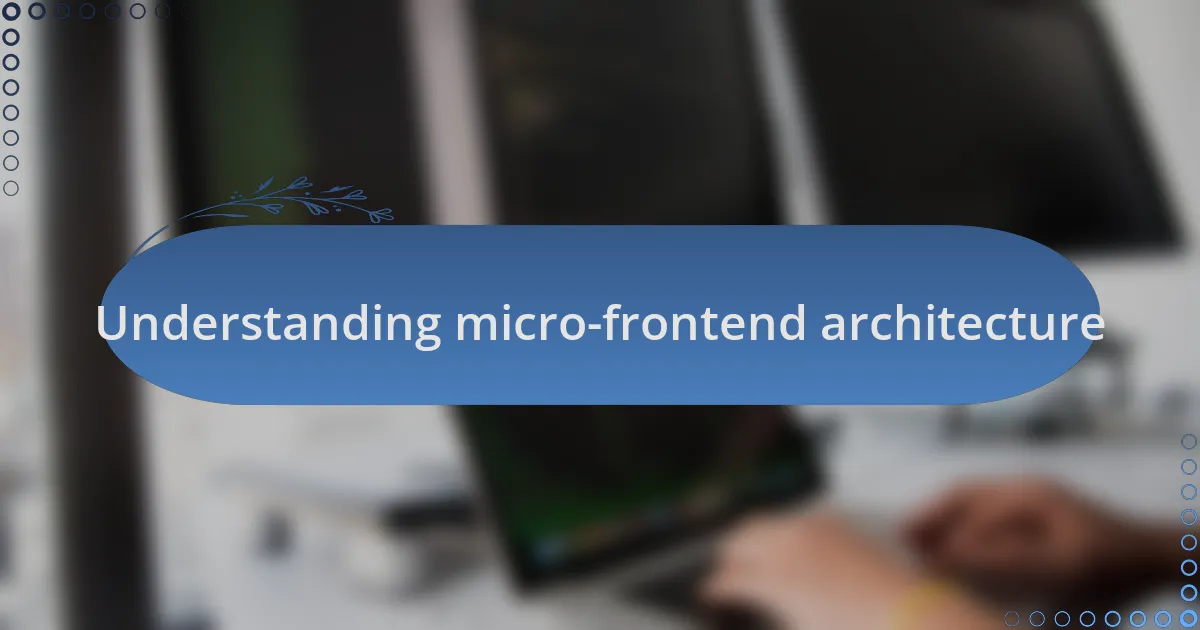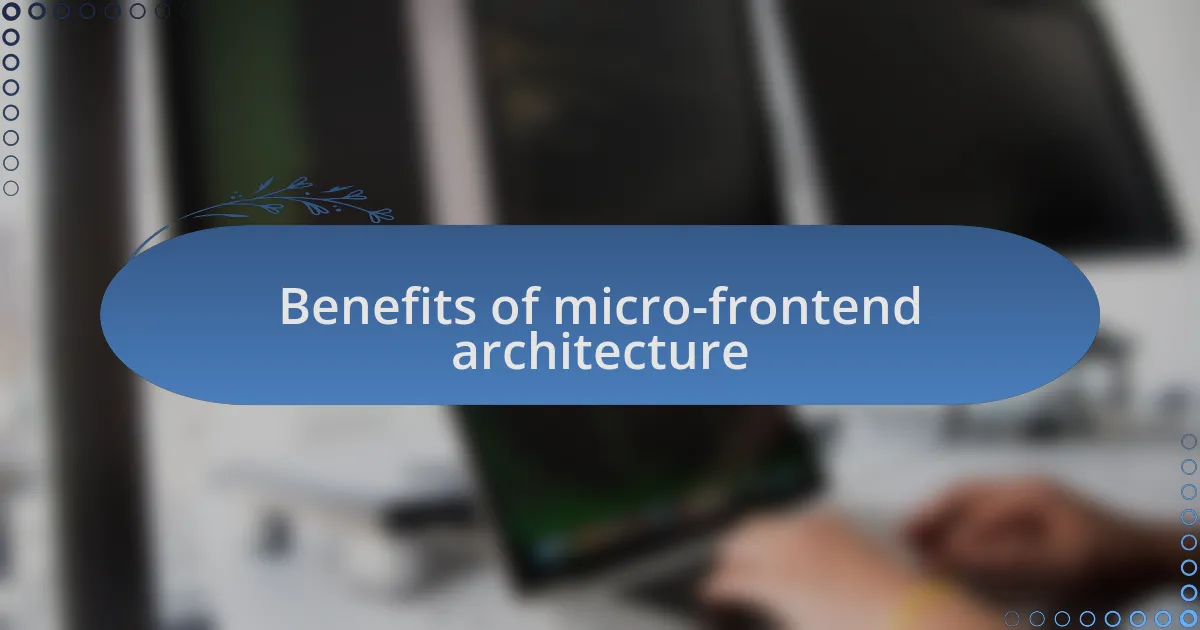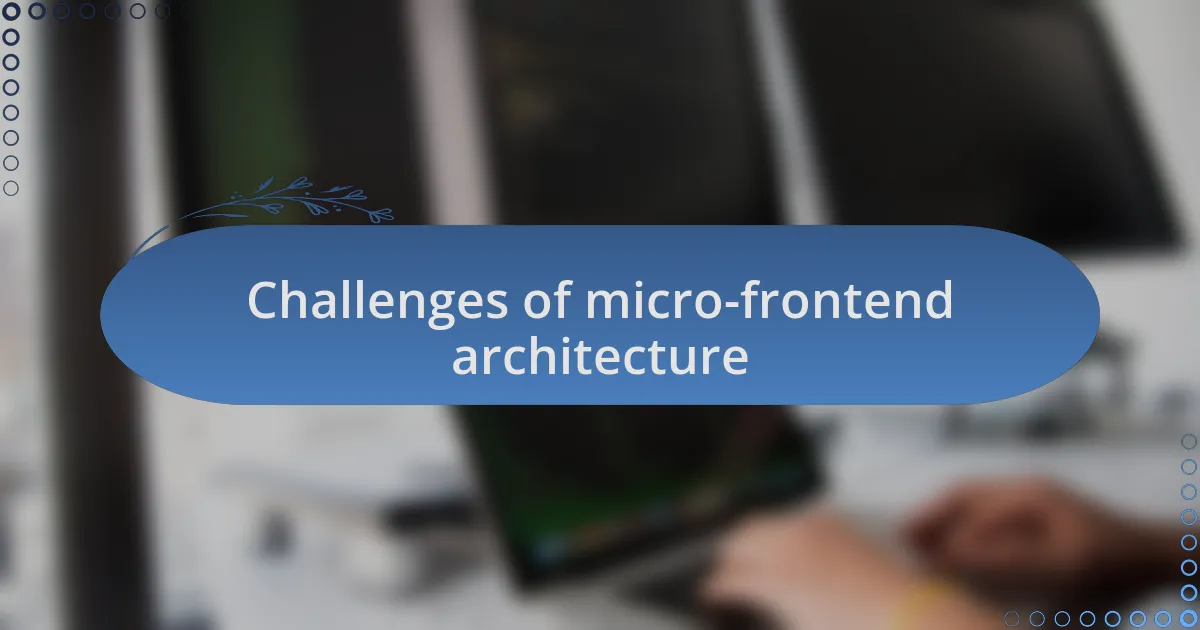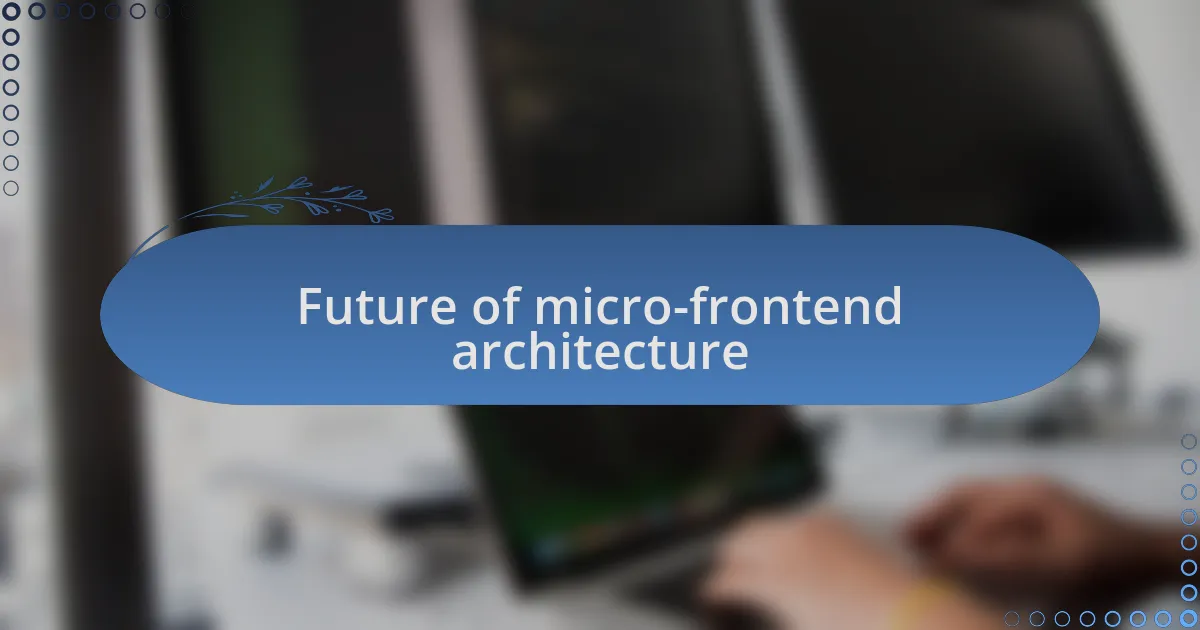Key takeaways:
- Micro-frontend architecture enables modular development, allowing teams to work independently and deploy updates without impacting the entire system.
- Benefits include the use of diverse technologies, improved performance, and easier maintenance compared to monolithic architectures.
- Challenges involve integration complexity, maintaining a consistent user experience, and increased operational overhead due to independent deployments.
- Best practices for success include establishing clear team boundaries, prioritizing shared components, and maintaining regular communication among teams.

Understanding micro-frontend architecture
Micro-frontend architecture is a design approach that breaks down a web application into smaller, manageable pieces, each responsible for a specific feature or functionality. I remember my first encounter with this concept; it was like seeing a massive puzzle finally being put together, where every piece has its unique shape yet fits perfectly into the larger picture. Doesn’t it feel liberating to think about tackling complex applications in such a modular way?
As I explored micro-frontends further, I realized that each team could independently manage their part of the application, fostering greater agility and innovation. This autonomy not only encourages creativity but also enhances collaboration among developers. Have you ever worked on a large team where coordinating changes felt like herding cats? This architecture facilitates that coordination by allowing teams to focus on their own micro-application without stepping on each other’s toes.
What really strikes me is the scalability that micro-frontend architecture offers. For example, when I transitioned a project to this model, it was eye-opening to see how easy it became to deploy updates without affecting the entire system. It made me wonder, how often do we cling to monolithic structures that slow us down, when a more flexible solution is right at our fingertips?

Benefits of micro-frontend architecture
One of the standout benefits of micro-frontend architecture is the ability to use diverse technologies across different teams. I remember a project where one team could leverage React while another opted for Vue.js, giving each group the flexibility to choose what best suited their skill set and project requirements. Don’t you find it exciting when teams thrive by using tools they’re passionate about, leading to not only better productivity but also enhanced end-user experiences?
Performance improvements are another significant advantage I encountered firsthand. In one instance, migrating to a micro-frontend structure reduced our initial load times significantly, as only the essential pieces of functionality had to be delivered upfront. It makes me reflect: how often do we settle for slower experiences when a well-architected approach can provide faster, more efficient outcomes?
Furthermore, maintaining and updating individual micro-frontends is a breeze compared to a monolithic setup. When I was involved in rolling out new features, each team could deploy independently without waiting in line for a larger release. This independence truly empowers teams to be proactive, don’t you think? It transformed how we approached releases, turning what used to be a stressful event into a smooth, continuous improvement process.

Challenges of micro-frontend architecture
When considering the challenges of micro-frontend architecture, one significant issue is the complexity of integrations. I recall a project where various teams struggled to ensure seamless communication between their independently developed components. It was frustrating to see how what should have been a straightforward API connection turned into a tangled web of incompatibilities. Have you ever faced a situation where so many moving parts made collaboration feel almost impossible?
Another common hurdle is maintaining a consistent user experience across different micro-frontends. I once worked on a site that tried to incorporate too many design styles from various teams, and the result was jarring for users. They were confused by the sudden shifts in layout and functionality, which made me wonder: how do we balance autonomy with the need for a cohesive brand image?
Lastly, the operational overhead can be surprisingly heavy. Managing multiple repositories, CI/CD pipelines, and deployments for micro-frontends requires a robust DevOps strategy. During one project, I found myself buried in coordinating deployments, which left less time for actual development work. Isn’t it ironic that the very flexibility we sought also led to an increase in our workload? The challenge lies in finding that sweet spot between flexibility and manageability.

Best practices for micro-frontends
To optimize the use of micro-frontends, it’s crucial to establish clear boundaries for each team involved. From my experience, defining the domain of responsibility upfront helps prevent overlaps that can lead to confusion. Have you ever seen a project go awry because roles weren’t clearly outlined? It can be a real nightmare.
Another best practice is to prioritize shared components and libraries. In a project I was involved with, we created a shared UI library that helped maintain consistency while allowing teams to develop independently. This not only streamlined our workflow but also empowered us to deliver a unified look and feel across the platform. How does one ensure that teams don’t reinvent the wheel? By fostering collaboration and sharing resources proactively.
Regular communication across teams is essential. In my previous endeavor, we implemented weekly sync-ups to discuss roadblocks and share updates. This initiative significantly improved our integration times and kept everyone aligned with the project goals. Have you considered how a simple meeting could transform your development experience? It’s remarkable how communication can bridge gaps and enhance collaboration in a micro-frontend architecture.

My experiences with micro-frontends
I’ve had some eye-opening experiences with micro-frontends that have really shaped my perspective. In one project, I was responsible for integrating a micro-frontend that handled user authentication. It was fascinating to see how breaking down the functionality into a smaller module not only simplified our codebase but also allowed the team to iterate quickly. Have you ever felt that sense of freedom when you realize you’re no longer tangled in a monolithic structure? It’s liberating.
Another noteworthy experience involved onboarding a new team member who was unfamiliar with our micro-frontend setup. Initially, I worried about whether they would struggle with the complexity. To my surprise, the learning curve was minimal thanks to the clear boundaries we had defined. I remember how relieved I felt when I saw them seamlessly contribute to the project within days. It made me appreciate how effective micro-frontends can be in promoting a culture of collaboration and ease of onboarding.
I’ve also learned that the emotional aspect can’t be ignored. There was a moment when a critical bug appeared because different micro-frontends were not communicating effectively. The tension in the air was thick as the team scrambled to resolve it. But once we tackled our communication strategy and laid down the expectations for each micro-frontend’s responsibilities, the stress significantly reduced. How do you think effective communication could have turned that stressful situation around? It’s a reminder that in the realm of micro-frontend architecture, not just the code but the team dynamics play a crucial role in success.

Lessons learned from using micro-frontends
One of the key lessons I’ve learned from using micro-frontends is the importance of standardization. In a project where components were developed by different teams, I observed that inconsistent design patterns led to a jarring user experience. It was frustrating to see our beautiful functionality marred by UI discrepancies. Have you ever experienced a well-oiled machine turn into chaos because everyone followed their own rules? Establishing common guidelines made all the difference, smoothing out the user journey.
Another insight came during a project where we attempted to integrate third-party services through various micro-frontends. I underestimated the challenges that came with versioning and compatibility. I recall a specific evening spent troubleshooting an outdated library that caused a ripple effect across multiple components. This highlighted the necessity of maintaining a clear strategy for managing dependencies. How often do we overlook the integration aspect in favor of development speed? Balancing innovation with stability is something I now prioritize.
Lastly, I came to appreciate the value of thorough documentation in micro-frontend projects. It’s easy to get excited about the coding aspects and forget the groundwork. I once found myself lost while trying to understand the decisions made by previous developers. After that experience, I made a commitment to document not just what we built, but why we made those choices. Have you ever found yourself wishing for a roadmap to navigate a project? Well-crafted documentation can be your guide, facilitating smoother handovers and collaborative efforts.

Future of micro-frontend architecture
As I look to the future of micro-frontend architecture, I can’t help but feel optimistic about its potential to redefine web development. I once collaborated on a project that harnessed the power of micro-frontends just as the concept was gaining traction, and it felt like exploring uncharted territory. The ability to break down complex applications into manageable parts allows teams to innovate more rapidly, but it also sparks questions: Will the increased modularity lead to a new era of creativity, or will teams struggle with coordination?
With the rise of technologies like single-spa and Module Federation, I foresee a shift towards even greater flexibility. I remember a project where we utilized a pioneering framework to allow seamless integration of micro-frontends, and the sense of freedom to experiment with different tech stacks was exhilarating. However, the paradox of choice can be daunting; how do we ensure that variety does not lead to fragmentation? Clear strategies for governance will be essential to navigate this evolving landscape.
Lastly, as companies continue to adopt micro-frontend architecture, the standards around interoperability will need to mature. Reflecting on a previous experience where two teams built components that fundamentally clashed, I realize how crucial it is to foster a culture of collaboration. Isn’t it interesting that what could be a path to independence can also lead to silos if not managed wisely? The future might hinge on creating seamless bridges between teams, helping them to share and learn from one another while maintaining the benefits of micro-frontends.